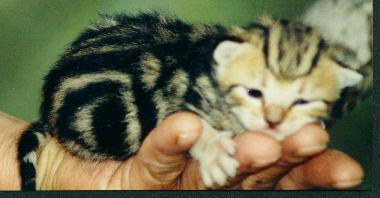African
Wild Cat
Our domestic cats had their origin with this wild cat. Can
you see similarities?
The three wild cat (felis sylvestris, felis lybica, felis ornata)
are found in Europe, Africa, Egypt, China. They inhabit both the wooded
areas and open grasslands and brush lands. It often nests in thickets or
discarded burrows of other animals.
This cat is 19 to 30 inches long with a tail half as long as its body. It
weighs between 10 and 25 lb. There seems to be a variation in coloration
but the normal color is yellowish gray with a cream to white throat and
underbelly. The forehead is striped with muted striping often on the body.
The distinct markings are on the tail which may have some darker rings and
tip. They have long legs compared to domestic cats that used in running
down their prey. They have five digits on the front feet and four digits
on the rear feet. All claws are retractable. Their dental formula is i3/3,
c1/1, p2/3, m1/1 x 2 for a total of 30. They are about 50% larger than domestic
cats.
Females have litters of 2-4 once per year, usually from May to August although
the female cycles for 2-8 days several times per year. They usually mate
in January through June. Gestation is 66 days. The babies nurse for 8 weeks,
and open their eyes at 10 days. The mother brings food home to them for
several more weeks after weaning, and they begin to hunt and travel with
her between three and five months. They are sexually mature at one and one
half years of age.
This cat is an rapid runner and skilled climber. It is capable of covering
great distances when hunting. The jungle cat usually preys on frogs, snakes,
rodents and rabbits. They are solitary in the wild. They are much sought
after for pets and have been crossed with several domestic breeds of cats.
They tend to be very vocal even when domesticated.
The minimum enclosure for this size cat would be 8' x 6' x 8' per cat. For
two cats, increase by 50%. If there are lots of interesting branches, rock
piles, etc. in the cage, the animals will have better quality living conditions.
Cats like perches near the top of the enclosure where they can watch the
goings on. Be sure to provide logs for scratching. The enclosure must have
at least one barrier behind which the animal can hide. Each cat needs a
den. The enclosure should have one holding area or shift area per cat to
facilitate safe cleaning, medication and restraint. This area should be
about 6 square feet in floor space. These cats need vaccinations against
feline distemper, rhinotracheitis and calcivirus twice a year. Killed vaccines
are the best. Killed rabies should also be given on an annual or every three
years basis.
Baby African Wild cat
about 3 weeks old.

|
The summer diet should consist
of 1 lb. of ground horse meat with vitamins added. Give horse ribs or tail
once a week. The winter diet is double that of the summer's. . You may wish
to use ZuPreem Feline canned and/or dry diet in place of the meat and vitamins.
Some owners feed their cats a mixture of Purina Mazuri Feline Diet and raw
ground meat. Feed bones weekly with some meat attached to promote good oral
health. A whole rat or part of a rabbit weekly provides interest for the
animal and added nutritional benefits.
Some of these cats have been raised entirely on commercial canned and dry
cat food with no ill effects.
R-Zu-2-U Home
R-Zu-2-U FAQs
R-Zu-2-U Animal "Terms"
Treasure Ranch Home


